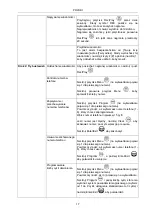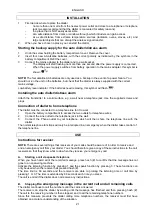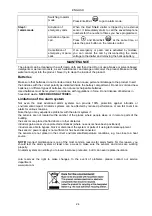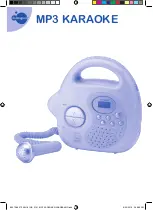
ENGLISH
21
INSTALLATION
1.
First decide where to place the dialler:
-
no more than one metre from the nearest power outlet and close to a telephone or telephone
jack (we also recommend that the dialler is concealed for safety reasons)
-
in a place that is NOT easily accessible
-
at a safe distance from doors or windows through which intruders can gain access
-
at a safe distance from extreme temperature sources (radiators, ovens, stoves, etc.) and
large metal objects that can disrupt the wireless signal transfer.
2.
When you have chosen a place, you can start the dialler.
Starting the backup supply for the auto dialler/distress alarm
1.
Undo the screw holding the battery compartment cover. Remove the cover.
2.
Insert four new AA alkaline batteries, with the correct polarity as indicated by the symbols in the
battery compartment. Refit the cover.
3.
Connect the mains adapter to the dialler and to a wall socket.
-
The display will start flashing no more than one second after the power supply is connected.
-
When the power supply switches from battery operation to the mains adapter, this symbol is
shown
.
NOTE!
The four alkaline AA batteries are only used as a backup in the event of a power failure. You
should not run the unit on the batteries, but check that the dialler is always supplied with the correct
mains voltage.
Low battery level indicator: If the batteries need replacing, this symbol will flash
.
Installing the auto dialler/distress alarm
Attach the transmitter to a solid surface, e.g. a wall near a telephone jack. Use the supplied screws and
plugs.
Connection of dialler to home telephone
The dialler must be connected to a telephone line for it to work.
1.
Open the battery compartment to access the two outlets for telephone wires.
2.
Connect the Line outlet to the telephone jack in the wall.
3.
Connect the Phone outlet to your telephone, which will then share the telephone line with the
dialler.
The normal telephone functions will only be interrupted in an emergency when the dialler takes control of
the telephone line.
USE
Instructions for receiver
NOTE.
There are several things that receivers of your calls should be aware of in order to receive and
end an emergency call from your dialler. You should therefore give a copy of these instructions to the call
receivers so that they know what to do when they receive your emergency call.
A.
Starting a call via speaker telephone
When you have heard all of the recorded message, press hash (#) to confirm that the message has not
gone to an answering machine.
Activate the listening function by pressing 1 and the speak function by pressing 3. These functions can
only be used when the receiver has pressed hash (#).
The time limit is 60 seconds and the receivers are able to prolong the listening time or call time by
pressing 1 or 3. The time is extended by 60 seconds each time you press.
The call is ended if the dialler does not receive any instructions.
B. Stopping
the emergency message in the current call and all remaining calls
The dialler continues to call the numbers until the call is answered.
The receiver can stop the dialler by waiting until the message has finished and then pressing hash (#).
The call to the receiving number is then stopped, and to all the remaining telephone numbers.
Since this measure prevents the dialler calling more telephone numbers, the receiver must first have
obtained an accurate understanding of the situation.
Summary of Contents for 41-087
Page 25: ......





































